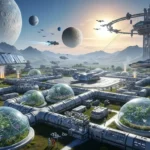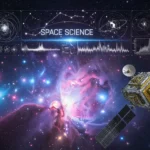Space vehicles, ranging from historic rockets to cutting-edge spacecraft, represent the engineering marvels that propel humanity into the vastness of space. This article explores the historical significance of space vehicles, the evolution of launch vehicles and spacecraft, their critical roles in space exploration, and the future innovations that will shape the next era of cosmic travel.
The Pioneering Rockets of Early Space Exploration
The journey of space vehicles began with the development of rockets that laid the foundation for human space exploration. Early pioneers in rocketry, such as Konstantin Tsiolkovsky and Robert H. Goddard, envisioned and designed the first propulsion systems capable of overcoming Earth’s gravitational pull.
V-2 Rocket – The Precursor to Space Travel
Developed during World War II by Nazi Germany, the V-2 rocket became the world’s first long-range guided ballistic missile. While initially a weapon of war, the V-2’s technology paved the way for subsequent advancements in rocket design, becoming a crucial precursor to the era of space exploration.
The Space Race and the Saturn V
The Cold War rivalry between the United States and the Soviet Union during the mid-20th century sparked the Space Race, resulting in monumental achievements in rocket technology. The Saturn V, developed by NASA, emerged as the iconic launch vehicle that propelled astronauts to the Moon during the Apollo missions.
Saturn V – The Moon Rocket
Standing over 363 feet tall, the Saturn V remains the most powerful rocket ever. Its historic role in the Apollo program culminated in the successful moon landings, with the Saturn V launching every crewed Apollo mission from 1967 to 1972. This colossal vehicle showcased humanity’s capability to reach beyond Earth’s orbit.
The Shuttle Era and the Space Shuttle
The advent of the Space Shuttle marked a new era in space transportation, offering reusable capabilities and the ability to deploy and retrieve satellites in orbit. The Space Shuttle program, led by NASA, operated from 1981 to 2011 and played a crucial role in constructing and servicing the International Space Station (ISS).
Space Shuttle – Reusable Orbital Vehicle
The Space Vehicles Shuttle introduced reusability to spaceflight with its orbiter, solid rocket boosters, and external tank. It conducted 135 missions, deploying satellites, conducting scientific experiments, and servicing the Hubble Space Telescope. The Shuttle era made significant contributions to advancements in satellite technology and space science.
Modern Launch Vehicles and Commercial Spaceflight
In the 21st century, the landscape of space vehicles has evolved with the emergence of commercial space companies. Innovators like SpaceX, Blue Origin, and others have introduced new launch vehicles prioritizing cost-effectiveness, reusability, and accessibility to low Earth orbit.
Falcon 9 – Reusable and Versatile
Developed by SpaceX, the Falcon 9 represents a new era in rocket design. Its first stage is designed to be reusable, landing back on Earth after launch. This innovation has significantly reduced the cost of accessing space, making it a go-to choice for satellite launches, cargo resupply missions, and crewed flights to the ISS.
New Shepard – Suborbital Tourism
Blue Origin’s New Shepard is designed for suborbital flights with the goal of space tourism. This vehicle, equipped with a reusable rocket and capsule, aims to offer civilians the Opportunity to experience a few minutes of weightlessness and see the curvature of the Earth from the edge of space.
Interplanetary Exploration and Spacecraft
While launch vehicles carry payloads into Space, spacecraft are the vehicles that explore distant destinations within our solar system and beyond. These robotic explorers gather invaluable data, conduct scientific experiments, and pave the way for potential human exploration.
Mars Rovers – Spirit, Opportunity, Curiosity, and Perseverance
NASA’s Mars rovers have played a crucial role in exploring the Martian surface. Spirit and Opportunity, launched in 2003, paved the way for subsequent missions, such as Curiosity, which continues to study the planet’s geology. The Perseverance rover, equipped with advanced instruments, aims to search for signs of past microbial life.
Voyager Probes – Interstellar Pioneers
Launched in 1977, the Voyager 1 and Voyager 2 probes embarked on a mission to explore the outer planets and are now on a trajectory to interstellar space. These spacecraft have provided unprecedented data about the outer planets and continue to transmit valuable information from the edges of our solar system.
New Horizons – Pluto Flyby
Launched in 2006, the New Horizons spacecraft conducted a historic flyby of Pluto in 2015, providing the first close-up images of the dwarf planet. This mission expanded our understanding of the outer reaches of our solar system and showcased the precision of modern space navigation.
Future Innovations in Space Vehicles
As humanity looks to the future, space vehicles are poised for transformative innovations that will shape the next era of cosmic exploration. Ambitious projects, such as lunar bases, Mars colonies, and interstellar missions, are driving advancements in propulsion, sustainability, and adaptability.
Artemis Program – Return to the Moon
NASA’s Artemis program aims to return humans to the Moon by the mid-2020s. The Space Launch System (SLS), NASA’s new heavy-lift launch vehicle, will play a crucial role in carrying astronauts back to lunar soil, paving the way for sustained lunar exploration and the eventual journey to Mars.
Starship – SpaceX’s Interplanetary Transport
SpaceX’s Starship represents an ambitious vision for interplanetary travel. Designed for both lunar and Mars missions, Starship is intended to be a fully reusable spacecraft capable of carrying large payloads and crews to destinations beyond Earth. If successful, it could revolutionize our approach to deep-space exploration.
Green Propulsion and Sustainability
Advancements in green propulsion technologies are emerging as a focus for future space vehicles. Environmentally friendly propellants, such as ion drives and other innovative systems, aim to reduce the environmental impact of space missions and enable sustainable exploration of our solar system.
Conclusion
Space vehicles, from the early rockets to the advanced spacecraft of today, embody humanity’s quest for exploration and discovery. The evolution of launch vehicles and spacecraft reflects our ingenuity, perseverance, and the insatiable Curiosity that drives us to explore the cosmos. As we stand on the cusp of new frontiers, the ongoing development of space vehicles promises a future where the mysteries of the universe continue to unfold through the collaborative efforts of scientists, engineers, and explorers.





